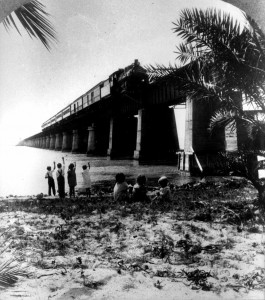 FLORIDA KEYS — A celebration honoring the 100th anniversary of the completion of the Florida Keys Over-Sea Railroad, once lauded as the most unique railway in the world, is under way in the Florida Keys. Events are to culminate Jan. 22, 2012, exactly 100 years after the inaugural train rolled through the island chain and arrived at Key West.
FLORIDA KEYS — A celebration honoring the 100th anniversary of the completion of the Florida Keys Over-Sea Railroad, once lauded as the most unique railway in the world, is under way in the Florida Keys. Events are to culminate Jan. 22, 2012, exactly 100 years after the inaugural train rolled through the island chain and arrived at Key West.
When the Over-Sea Railroad train made its first journey in 1912 it connected the previously isolated Florida Keys with the mainland and each other for the first time, forever changing the face of the island chain.
Events commemorating the centennial year include a one-man performance by a re-enactor portraying railroad founder Henry Flagler, museum exhibitions, hobbyist train displays and historic re-creations, a “family fun” day at the former railroad workers’ camp on Pigeon Key, a Keyswide kayak adventure following the railroad’s route, a presentation by noted railroad historian Seth Bramson, a period costume ball and a Key West community parade.
The rail line was conceived by Standard Oil tycoon Flagler and construction began in 1905, motivated by an announcement that the Panama Canal would be built. Flagler thought Key West had the potential to be an important port and trade route with Cuba and Latin America, as well as a vital supply stop for ships entering or exiting the Panama Canal.
The railroad’s track stretched more than 100 miles out over open water, requiring trailblazing construction techniques and herculean efforts. At several points in the construction process more than 4,000 men were working on the project, and Flagler gambled nearly all his wealth on the venture.
Officially named the Florida East Coast Railway’s Key West Extension, the line became known as the Florida Keys Over-Sea Railroad and was sometimes referred to as “the eighth wonder of the world.” The bridges and viaducts connecting the Keys, including the landmark Seven Mile Bridge at Marathon, were regarded as an engineering marvel.
For more than two decades after the railroad’s 1912 completion it carried passengers to the Keys and Key West, affording them a breathtaking sense of steaming across the open ocean.
The Over-Sea Railroad’s heyday ended abruptly when a portion of the line was destroyed in a 1935 hurricane. Less than three years later a narrow highway for automobiles replaced the tracks.
Today many of the original railroad bridges still can be seen alongside the bridges that support the modern Florida Keys Overseas Highway, the contemporary connection from mainland Florida through the Keys.
Other reminders of the historic railroad include Pigeon Key, a five-acre island that lies beneath the Old Seven Mile Bridge at Marathon. A base camp for workers during construction of the original railroad bridge, the tiny island now features carefully restored structures and a museum dedicated to the railway and its builders.
Visitors to Key West can view “Flagler’s Speedway to Sunshine,” an exhibition at the Key West Museum of Art & History at the Custom House. Elements include a re-created Florida East Coast railcar, a scale replica of a section of the Seven Mile Bridge, vintage footage of the journey from Pigeon Key to Key West, a film recounting Flagler’s story and the arrival of the first train, rare artifacts such as a conductor’s uniform and railroad worker’s tool chest, and memorabilia that brings alive the fascinating story of the railroad that went to sea.
Over-Sea Railroad centennial information: www.FlaglerKeys100.com
Florida Keys visitor information: www.fla-keys.com or 1-800-FLA-KEYS (1-800-352-5397)
Social: facebook.com/floridakeysandkeywest • twitter.com/thefloridakeys • YouTube.com/FloridaKeysTV
